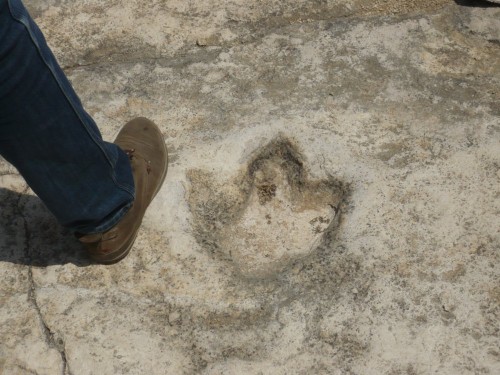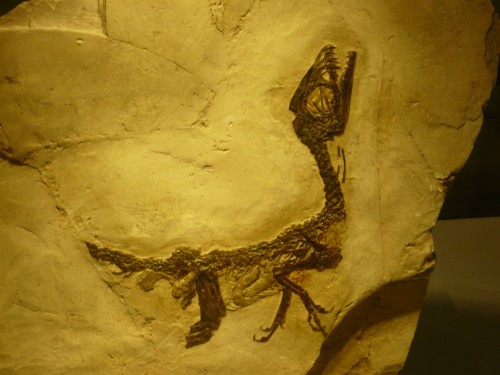Daniele Tona – giugno 2014


Anche quest’anno, nei giorni 11, 12 e 13 giugno, la Società Paleontologica Italiana si è riunita per il suo congresso annuale, che per la quattordicesima edizione ha scelto come sede la città di Bari. Nel Salone degli Affreschi del Palazzo Ateneo, presso l’Università degli Studi “Aldo Moro”, comunicazioni orali e poster hanno illustrato le ultime novità da parte della comunità paleontologica del nostro paese. Come ormai è una ricorrenza annuale, anche nel 2014 Scienzafacile era presente nella persona del sottoscritto, che in queste poche righe vi riporterà i fatti più salienti della tre giorni paleontologica pugliese.
Il primo giorno del congresso, mercoledì 11 giugno, è stato interamente dedicato alle comunicazioni orali, intervallate da tre interventi a invito: il primo, di Antonietta Cherchi dell’Università di Cagliari, ha inaugurato i lavori presentando uno studio sui trend evolutivi dei foraminiferi orbitolinidi della piattaforma Apula durante il Cretaceo Inferiore, e la loro importanza come strumenti per la correlazione biostratigrafica nell’area della Tetide. Giorgio Manzi, dell’Università La Sapienza di Roma, ha aperto la seconda sessione illustrando le ricerche svolte sui resti dell’uomo di Altamura, uno scheletro umano rinvenuto in una grotta che tra l’altro ha riguardato una delle tappe dell’escursione (ma torneremo più avanti su questo). La terza comunicazione, in apertura della sessione pomeridiana, ha visto invece Cristiano Dal Sasso del Museo di Storia Naturale di Milano descrivere i risultati del lungo e accurato studio di Scipionyx samniticus, il cucciolo di dinosauro noto al grande pubblico come Ciro, per quello che riguarda la preservazione delle parti molli – ancor più incredibile di quanto si pensasse in partenza – e dei resti delle prede trovate nelle sue viscere.

Le comunicazioni orali hanno coperto come sempre una vasta gamma di gruppi tassonomici, epoche e località, spaziando nell’arco delle quattro sessioni da lavori descrittivi come quelli sul rinoceronte Stephanorhinus, sul pesce syngnathoide Gasterorhamphosus, sull’evoluzione del gatto selvatico e sui coralli pleistocenici calabresi, ad altri più mirati a studi paleoclimatici e paleoambientali tramite l’impiego dei fossili, soprattutto microfossili come foraminiferi, diatomee o pollini ma anche macrofossili come bivalvi e brachiopodi; alcuni di questi studi hanno riguardato contesti molto vicino a noi nel tempo – parliamo dell’Olocene quindi grossomodo dell’ultimo milione di anni – e sono arrivati addirittura in epoca storica come un lavoro sui sedimenti dell’antico Porto di Traiano, laddove altri hanno invece toccato epoche più remote come gli eventi anossici durante il periodo Cretaceo; in alcuni casi lo stesso sito è stato trattato da varie comunicazioni che si sono soffermate su differenti suoi aspetti: un esempio è la Formazione Pisco del Mio-Pliocene del Perù, che durante la prima giornata è stata oggetto di una comunicazione riguardante i vertebrati marini rinvenuti in essa (fra cui soprattutto i cetacei) e di un’altra sui depositi diatomitici della stessa unità, a cui si è poi aggiunta una terza presentazione l’ultimo giorno stavolta focalizzata sui cetacei della famiglia degli Ziphiidae.
Una comunicazione in particolare merita una menzione per il tipo di lavoro illustrato, riguardante i due siti pleistocenici di Coste San Giacomo e Fontana Ranuccio nel bacino di Anagni. L’Istituto Italiano di Paleontologia Umana ha infatti realizzato un’applicazione per smartphone (al momento disponibile solo per sistemi iOS e reperibile su Itunes col nome IsIPU) che fornisce una guida virtuale dei due siti, con modelli a tre dimensioni degli animali rinvenuti e ricostruzioni a realtà aumentata dell’ambiente in cui sono vissuti. Mi permetto di soffermarmi su di essa, tra tante ricerche presentate, per il suo grande potenziale come strumento di divulgazione, in quanto riesce a dare all’utente molte informazioni in modo esaustivo ma soprattutto accattivante, anche per chi non ha una conoscenza accademica dell’argomento o semplicemente non ha tempo o voglia di immergersi nella lettura di una lunga trattazione; in questo modo anche chi è un semplice appassionato può documentarsi senza che sfilze di termini tecnici rischino di ostacolare la sua comprensione. Sarebbe bello se ogni sito paleontologico, italiano e non, disponesse di analoghi mezzi per raccontare al grande pubblico la sua storia e i tesori sotto forma di fossili che ospita, di modo da rendere davvero fruibile a tutti una disciplina come la paleontologia che già di per sé suscita meraviglia e interesse anche nell’uomo della strada.
Ma torniamo al congresso e più precisamente alla seconda giornata, dedicata all’escursione sul terreno che ha coperto il territorio delle Murge a ovest di Bari. Volendo dare un piccolo inquadramento geologico dell’area, le Murge sono una serie di ampi horst e graben (ossia rilievi del territorio separati l’uno dall’altro da scarpate e aree a quota più bassa); il ripiano più elevato è noto come Alta Murgia ed è ricco di forme carsiche fra cui doline (qui chiamate “puli”) spesso di diametro e profondità molto elevati; è inoltre qui che sono ubicati il terzo e il quarto stop della giornata. Quelli che discendono via via di quota verso la costa adriatica sono invece le Murge Basse, dove si sono svolti i primi due stop. Le Murge, e più in generale l’intera Puglia, rappresentano le vestigia della placca Apula o Adria, una propaggine della placca Africana formatasi nel Paleozoico Superiore. Durante il Mesozoico la placca Apula era un margine continentale passivo presso cui si svilupparono delle piattaforme carbonatiche, una delle quali, la Piattaforma Apula, è oggi ravvisabile nei vari ammassi calcarei pugliesi tra cui anche le Murge. Nel corso dei milioni di anni la tettonica e le fluttuazioni del livello del mare portarono all’emersione delle piattaforme, creando aree in cui animali di terraferma come i dinosauri potevano transitare lasciando impronte come quelle oggetto del secondo stop. Alla fine del Cretaceo la Piattaforma Apula emerse e divenne un’area continentale interessata da carsismo; dal Miocene Inferiore divenne l’avampaese della catena appenninica in formazione più a ovest, e interessata dalla conseguente tettonica si inarcò dividendosi in vari blocchi rilevati che oggi sono il Gargano, le Murge e il Leggi tutto “GIORNATE DI PALEONTOLOGIA A BARI, 11-13 GIUGNO 2014”


